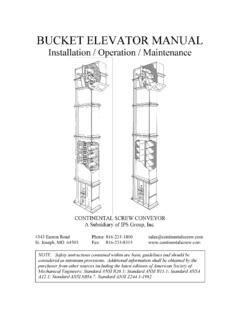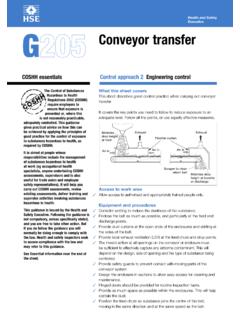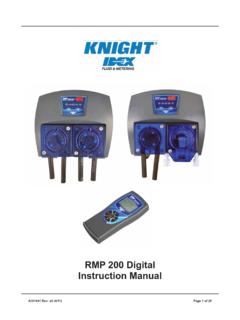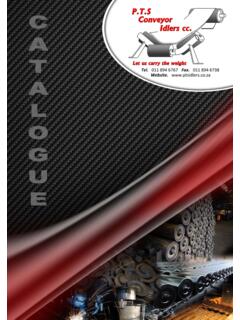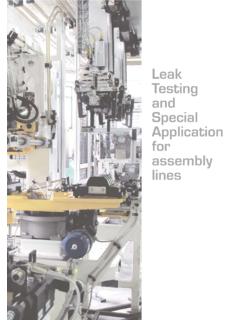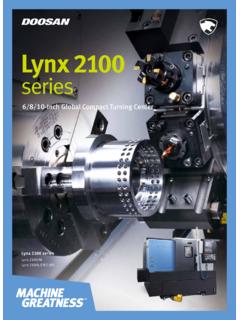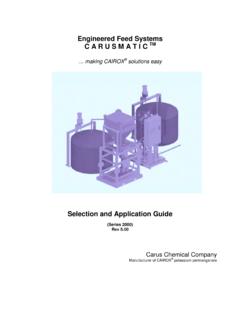Transcription of BELT - Continental Screw
1 belt conveyor INSTALLATION, OPERATION Maintenance and safety manual Continental belt conveyor SYSTEMS By Continental Screw conveyor A Subsidiary of IPS Group, Inc. 4343 Easton Road Phone: 816-233-1800 St. Joseph, MO 64503 Fax: 816-233-8315 NOTE safety instructions contained within are basic guidelines and should be considered as minimum provisions. Additional information shall be obtained by the purchaser from other sources including the latest editions of American Society of Mechanical Engineers; Standard ANSI ; Standard ANSI ; Standard ANSA ; Standard ANSI ; Standard ANSI Installation, Operation, Maintenance and safety manual Page 1 Suggested Installation, Operation, Maintenance and safety Procedures applicable to Continental belt conveyor Systems Equipment This is a general guideline for the operation, maintenance and safety procedure for belt conveyors manufactured by Continental belt conveyor Systems (CBCS).
2 It is intended to provide general engineering information on belt conveyors and is not intended to circumvent or modify any information supplied by the manufacture of any of the purchased components supplied with this equipment. The information contained herein should be made available to be studied by any of your plant and office personnel who may be expected to operate, inspect, work on - or in any way come in contact with this equipment. This should be done prior to putting the equipment into operation. INSTALLATION Prior to receiving the equipment you normally will be furnished with a general arrangement drawing provided by CBCS of your equipment layout, which includes all pertinent elevations and dimensions. This drawing shows the configuration of he conveyor and location of the support points if we are to supply conveyor supports. In the cases where CBCS is to supply supports, there will be an anchor bolt size and setting plan given to accept the base plates of the these supports.
3 Please review this drawing and if any discrepancies occur in the layout drawing and the actual jobsite condition contact CBCS immediately. Because of varying soil conditions, CBCS does not specify foundation sizes for the equipment. We recommend that you consult a qualified engineer in your area that can determine the exact foundation requirements to handle the individual system components. If required, the loads created by the conveyor we furnish can be shown on the general arrangement drawings. All piers, footings and foundations should comply with local building codes. When you receive your shipment of equipment it is important that you immediately inspect the shipment against the accompanying shipping list. If any of the goods called for on the freight bill are short or damaged, do not accept or sign the bill until the delivery agent makes proper notation to this effect on your freight bill.
4 This is absolutely necessary as the freight bill is an acknowledgment to the transportation company that the goods were received in good condition. This must be done, as the transportation companies will not honor any claim for loss or damage equipment. If the delivery agent will not make the proper notations, then you should file an affidavit stating your notification along with the proper time and date. This will aid in supporting your claim. Once the equipment is received it is necessary that the proper storage precautions be taken in order to assure against damage due to weather and other unpredictable acts. Keeping in mind the sequence of assembly and easy accessibility. All major components should be placed on blocks to prevent possible damage. If the equipment will not be installed for a lengthy period of time, cover any components that could be damaged by weather elements. Installation, Operation, Maintenance and safety manual Page 2 All hardware and small components that are received in crates should be resealed after inspecting the contents for damage.
5 All shipping containers should be blocked-up and covered from the elements until actual erection of the system begins. Your equipment may have traveled many hundreds of miles by truck and during the trip haul vibration may have caused bolts or setscrews to work loose. During installation and prior to operating the equipment a visual inspect should be done to check and tighten any such fasteners. Installation of the conveyor should in accordance with the drawings provided by CBCS, these drawings provide the general arrangement of the conveyor and an overall view of the finished conveyor . Proper erecting equipment will be required; this equipment will be dependent on the type of conveyor , frame construction, configuration and length of the conveyor and will be at the discretion of the company or general contractor in charge of installing the conveyor . Depending on how your equipment was quoted and provided will dictate how you receive it and the amount of assembly work that will be required by field personnel.
6 The following is a list of the major components of a belt conveyor and how they would normally be supplied CBCS to the field. Tail Section: Assembly with the tail pulley, tail shaft, bearings and take-up assembly if manually adjusted, idlers and return rolls. If the inlet loading area is small enough it may be assembled to the tail section. If the inlet areas to too large it will be shipped loose for field assembly because installing the belt is difficult. Intermediate Section: Depending on what type - channel frame or truss frame may have the idlers attached. Shipping of truss sections with idlers may create an over height load. Gravity Take-up Section: Normally supplied on conveyors in excess of 150 in length conveyor Supports: Normally constructed in one welded assembly in lengths up to 25 , supports longer than this are bolted construction and will require field assembly. Inlet, Discharge or Diverter Sections: Normally constructed in one welded assembly, only in cases where these assemblies are excessive longer or angular would there be two sections and a bolted jointed to be assembled in the field.
7 Idlers and Returns: Normally would be shipped attached to the conveyor frame, the exception would be as discussed for the intermediate sections. In the case where idlers and returns were shipped loose acre must be taken to assemble the proper type of idlers and return to the proper location. Transition idlers normally would be at carrying side of the tail and head and training idlers would be spaced approximately 100 on center, the general arrangement drawing will identify the type and location of these idlers. Belting: Normally would be shipped as a roll and field installed with a mechanical splice furnished by CBCS (Note: Mechanical splice and templet furnished by CBCS tools required by the field installer). The belt furnished by CBCS will have enough additional to allow for a field-vulcanized splice as required. (Note: Vulcanizing and materials required by the field installer) Walkway and Handrail: Walkway and handrail sections along with the walkway support system usually on 5 -0 centers are shipped as loose items and will require field assembly.
8 Installation, Operation, Maintenance and safety manual Page 3 Accessories: safety switches such as emergency stop, safety pull cord, motion sensor, belt misalignment and plugged are all shipped loose for field installation due to possible damage during shipment. Brackets for these items will be supplied and attached to the conveyor frame by CBCS. Normal conveyor installations begin at the tail sections and proceed towards the head section. Each conveyor and situation is different thus a determination must be made by the company or the contractor in charge of installation as to the best approach for their installation. The installation of the conveyor should ensure that the frame is level and that a good alignment exists at all of the pulley locations, idlers and returns. Once this alignment is achieved the conveyor frame should be secured to the support and all bolted joints tighten to the proper torque.
9 The alignment of the conveyor frames differs based on their application, the ideal installation would achieve an alignment of plus or minus 1/8 in conveyor frames 50 -0 center-to-center of pulleys length or less. For longer applications 1/4 in 100 -0 with a maximum out of alignment of 1/2 on the length up to 500 -0 . A final inspection of the overall installation should be done to check for potential problems, loose joints, or forgotten pieces prior to the belt being powered up for training. This inspection process could include the plant operates, it will give them a good opportunity to examine and to become familiar with it before there is any material run on the system. Stop all moving machinery during periods of lubrication, maintenance, or adjustment and provide that the equipment cannot be restarted during such procedures!!!! OPERATION The operation of each belt conveyor differs with its application.
10 Once the installation is satisfactorily completed and all of the bearings, idlers, reducers, etc. are proper lubricated and the safety devices are installed the conveyor is ready for operation. belt conveyors are designed to conveyor a given amount of particular material, the width of the belt , speed and horsepower have been based on that criteria and any deviation can cause serious effects to the belt conveyor . The effect of changing any of the determining factors in the design of the belt conveyor will mostly result in excessive costly downtime, spilled material and cleanout, decrease efficiency, annoying motor trip outs and reduce the life of the conveyor and components. We have provide a trouble shooting chart to help you with commonly experienced problems: Installation, Operation, Maintenance and safety manual Page 4 COMPLAINT CAUSE In order of probable occurrence belt runs off at tail pulley 7 15 14 17 21 -- Entire belt runs off at all points of the line 26 17 15 21 4 16 One belt section runs off at all points of the time 2 11 1 -- -- -- belt runs off at head pulley 15 22 21 16 -- --- belt runs to one side throughout entire length at specific idlers 15 16 21 -- -- -- belt slip 19 7 21 14 22 -- belt slip on starting 19 7 22 10 -- -- Excessive belt stretch 13 10 21 6 9 8 belt breaks at or behind fasteners.
